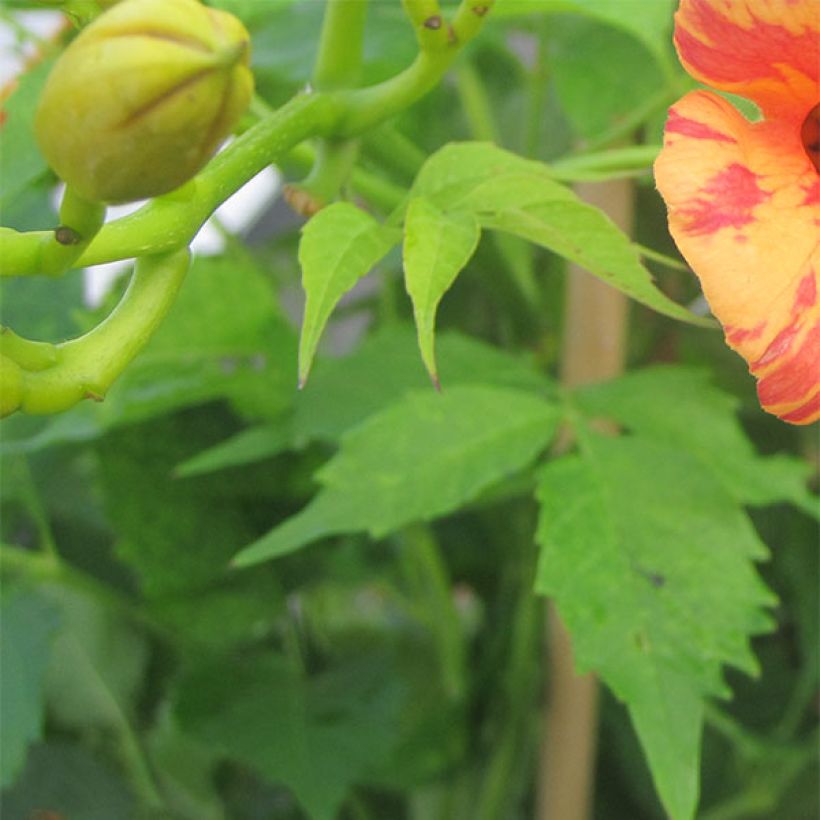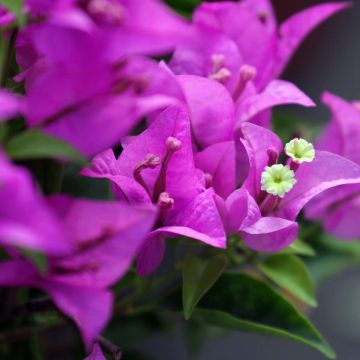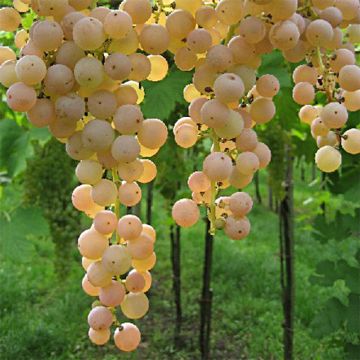

Campsis radicans x grandiflora Orangeade


Campsis radicans x grandiflora Orangeade


Campsis radicans x grandiflora Orangeade


Campsis radicans x grandiflora Orangeade


Campsis radicans x grandiflora Orangeade
Campsis radicans x grandiflora Orangeade
Campsis radicans x grandiflora Orangeade
Trumpet Vine
The Bignonia received had several branches without leaves. Only one had 2 green, leafy branchings. Once planted, it has held up well in this condition since then. I'm therefore confident for a good recovery next summer.
Marie-christine, 28/10/2025
Special offer!
Receive a €20 voucher for any order over €90 (excluding delivery costs, credit notes, and plastic-free options)!
1- Add your favorite plants to your cart.
2- Once you have reached €90, confirm your order (you can even choose the delivery date!).
3- As soon as your order is shipped, you will receive an email containing your voucher code, valid for 3 months (90 days).
Your voucher is unique and can only be used once, for any order with a minimum value of €20, excluding delivery costs.
Can be combined with other current offers, non-divisible and non-refundable.
Home or relay delivery (depending on size and destination)
Schedule delivery date,
and select date in basket
This plant carries a 6 months recovery warranty
More information
We guarantee the quality of our plants for a full growing cycle, and will replace at our expense any plant that fails to recover under normal climatic and planting conditions.

Would this plant suit my garden?
Set up your Plantfit profile →
Description
The Orangeade Trumpet Vine, also known as Campsis x tagliabuana Orangeade, is a recent, unique, and elegant French hybrid that blooms from a young age, from May to September, with beautiful red-orange trumpets marbled with pale orange. Its deciduous foliage takes on a lovely bright green shade, which creates a beautiful backdrop for the flowering. It attaches itself to supports using its branches equipped with climbing roots. It is undemanding in terms of soil type, and quite hardy, thriving in sunny or partially shaded climates.
Campsis x tagliabuana is a plant from the Bignoniaceae family, resulting from a cross-breeding between Campsis radicans, native to the hot and dry regions of the southeastern United States, and Campsis grandiflora, native to China. Recently obtained by a French nursery, the 'Orangeade' trumpet vine is a deciduous vine with a woody base that produces underground stolons. It grows rapidly and can reach a height of 5 to 8 metres (16 to 26 feet) in a few years. The abundant flowering occurs from the early years of cultivation. It is very spread out, starting in June and continuing until September or October. The flowers bloom in the axils of the leaves, in dense clusters of 4 to 12 trumpets, 5 cm (2in) long, with 5 lobes. Each flower is different, but they are all variegated with red-orange and pale orange, sometimes favouring red, sometimes pastel orange. The deciduous foliage is composed of leaves divided into 7 to 11 ovate leaflets with crenate edges. It is its branches equipped with climbing roots that allow the plant to attach itself to its support.
Campsis x tagliabuana 'Orangeade' can be used anywhere, to cover a wall sheltered from cold winds, an unsightly building, a well-exposed facade, a fence, or an old wall. This plant can withstand temperatures down to -15°C/-20°C (-4°F) and must be protected from strong winds that could bend its branches. That is its only requirement and perhaps its only weakness since it can grow in any ordinary but well-draining soil, even occasionally dry or slightly calcareous, without hindering its joyful flowering. For example, you can combine it with other unique climbing plants such as Actinidia kolomikta, Clematis 'Black Tea', or Clematis 'H F Young', which has a vibrant blue colour, to create a colourful scene.
Report an error about the product description
Campsis radicans x grandiflora Orangeade in pictures




Plant habit
Flowering
Foliage
Botanical data
Campsis
radicans x grandiflora
Orangeade
Bignoniaceae
Trumpet Vine
Cultivar or hybrid
Other Campsis - Trumpet Creeper
View all →Planting and care
The Orangeade trumpet vine is a plant that is undemanding in terms of soil type, but it dislikes heavy, compact, poorly drained soils where moisture can stagnate. If the soil in your garden is too heavy, incorporate coarse sand or gravel before planting. It grows well in any well-drained garden soil, even if it is somewhat poor and slightly chalky. It prefers a sunny position, except in the south of our country where it will thrive in partial shade. Plant it along a well-exposed wall or against a tree, guiding it with a stake. Water regularly in the first summers, or in case of prolonged drought. Once established, the plant can tolerate occasional dry periods. In the first few years, protect the base from severe frosts with a thick mulch. Pruning is not essential. If necessary, prune in late winter or early spring. In August-September, remove faded branches as well as the oldest shoots, which can be recognised by their cracked bark.
Planting period
Intended location
Care
-
, onOrder confirmed
Reply from on Promesse de fleurs
Similar products
Haven't found what you were looking for?
Hardiness is the lowest winter temperature a plant can endure without suffering serious damage or even dying. However, hardiness is affected by location (a sheltered area, such as a patio), protection (winter cover) and soil type (hardiness is improved by well-drained soil).

Photo Sharing Terms & Conditions
In order to encourage gardeners to interact and share their experiences, Promesse de fleurs offers various media enabling content to be uploaded onto its Site - in particular via the ‘Photo sharing’ module.
The User agrees to refrain from:
- Posting any content that is illegal, prejudicial, insulting, racist, inciteful to hatred, revisionist, contrary to public decency, that infringes on privacy or on the privacy rights of third parties, in particular the publicity rights of persons and goods, intellectual property rights, or the right to privacy.
- Submitting content on behalf of a third party;
- Impersonate the identity of a third party and/or publish any personal information about a third party;
In general, the User undertakes to refrain from any unethical behaviour.
All Content (in particular text, comments, files, images, photos, videos, creative works, etc.), which may be subject to property or intellectual property rights, image or other private rights, shall remain the property of the User, subject to the limited rights granted by the terms of the licence granted by Promesse de fleurs as stated below. Users are at liberty to publish or not to publish such Content on the Site, notably via the ‘Photo Sharing’ facility, and accept that this Content shall be made public and freely accessible, notably on the Internet.
Users further acknowledge, undertake to have ,and guarantee that they hold all necessary rights and permissions to publish such material on the Site, in particular with regard to the legislation in force pertaining to any privacy, property, intellectual property, image, or contractual rights, or rights of any other nature. By publishing such Content on the Site, Users acknowledge accepting full liability as publishers of the Content within the meaning of the law, and grant Promesse de fleurs, free of charge, an inclusive, worldwide licence for the said Content for the entire duration of its publication, including all reproduction, representation, up/downloading, displaying, performing, transmission, and storage rights.
Users also grant permission for their name to be linked to the Content and accept that this link may not always be made available.
By engaging in posting material, Users consent to their Content becoming automatically accessible on the Internet, in particular on other sites and/or blogs and/or web pages of the Promesse de fleurs site, including in particular social pages and the Promesse de fleurs catalogue.
Users may secure the removal of entrusted content free of charge by issuing a simple request via our contact form.
The flowering period indicated on our website applies to countries and regions located in USDA zone 8 (France, the United Kingdom, Ireland, the Netherlands, etc.)
It will vary according to where you live:
- In zones 9 to 10 (Italy, Spain, Greece, etc.), flowering will occur about 2 to 4 weeks earlier.
- In zones 6 to 7 (Germany, Poland, Slovenia, and lower mountainous regions), flowering will be delayed by 2 to 3 weeks.
- In zone 5 (Central Europe, Scandinavia), blooming will be delayed by 3 to 5 weeks.
In temperate climates, pruning of spring-flowering shrubs (forsythia, spireas, etc.) should be done just after flowering.
Pruning of summer-flowering shrubs (Indian Lilac, Perovskia, etc.) can be done in winter or spring.
In cold regions as well as with frost-sensitive plants, avoid pruning too early when severe frosts may still occur.
The planting period indicated on our website applies to countries and regions located in USDA zone 8 (France, United Kingdom, Ireland, Netherlands).
It will vary according to where you live:
- In Mediterranean zones (Marseille, Madrid, Milan, etc.), autumn and winter are the best planting periods.
- In continental zones (Strasbourg, Munich, Vienna, etc.), delay planting by 2 to 3 weeks in spring and bring it forward by 2 to 4 weeks in autumn.
- In mountainous regions (the Alps, Pyrenees, Carpathians, etc.), it is best to plant in late spring (May-June) or late summer (August-September).
The harvesting period indicated on our website applies to countries and regions in USDA zone 8 (France, England, Ireland, the Netherlands).
In colder areas (Scandinavia, Poland, Austria...) fruit and vegetable harvests are likely to be delayed by 3-4 weeks.
In warmer areas (Italy, Spain, Greece, etc.), harvesting will probably take place earlier, depending on weather conditions.
The sowing periods indicated on our website apply to countries and regions within USDA Zone 8 (France, UK, Ireland, Netherlands).
In colder areas (Scandinavia, Poland, Austria...), delay any outdoor sowing by 3-4 weeks, or sow under glass.
In warmer climes (Italy, Spain, Greece, etc.), bring outdoor sowing forward by a few weeks.


















































